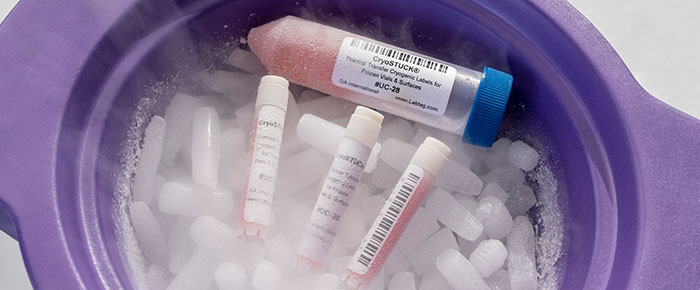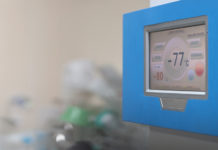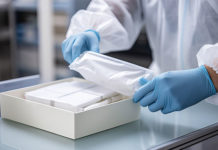
It’s an age-old question everyone who has ever worked with frozen cells and samples has asked: how long can I keep my stuff in the freezer? Some scientists have even taken an interest in determining the viability of long-term cryo storage and what happens when samples are stored for years in -80°C freezers and liquid nitrogen Dewars, all in an attempt to verify the integrity of old samples and to ascertain whether researchers should be using them or not.
How should sample integrity be measured?
The first step to assessing how long samples can be stored is to determine what constitutes degraded samples. Not all cellular components degrade at the same speed; DNA, considered relatively stable, can be left in the fridge for quite a while if stored in the proper buffer. Meanwhile, RNA and proteins degrade much faster. Thus, RNA integrity appears to be widely considered one of the most reliable measures of sample integrity and has been used in various studies to illustrate the effects of long-term storage.1-4 RNA integrity can be assessed using a bioanalyzer, which yields an RNA integrity number (RIN). RINs, based on an algorithm that measures parameters derived from an electropherogram profile, range from 1 to 10, with a 10 suggesting the RNA is fully intact.1 Keep in mind that cellular morphology also needs to be considered. For samples of live cell lines, a host of variables come into play, like growth and recovery rates from cold storage and their responses to stimuli.
So, -80°C freezers or liquid nitrogen?
For years, liquid nitrogen storage, which typically provides a temperature of around -196°C, has been considered the gold standard in sample preservation. This is likely because -135°C is the temperature at which biological activity completely halts, being under the glass transition point of water. Many still consider freezers working at -80°C to provide subpar long-term sample storage. Unfortunately, studies to prove this theory are few and far between, though the ones that have been published paint a rosier picture of -80°C storage.
Cancer tissues are one of the samples most studied for long-term cryo storage. At least three separate articles have previously reported on storing cancer tissues, including samples from patients with breast cancer, gastric cancer, and other samples from the Ontario Tumour Bank. In each article, RNA integrity was used as a correlate for sample integrity, with an insignificant amount of degradation occurring over 10 to 12 years (depending on the study). One study, using histological analysis of gastric cells, showed no noticeable morphologic changes to the cells. However, the study that used breast cancer tissue showed a relatively high rate of abnormal nuclei via histological staining as well as membrane abnormalities via electron microscopy.2-4 Though this still needs to be confirmed, it would seem that, while freezers can provide adequate long-term cryo storage for macromolecules, relying on -80°C for anything more, such as storage of live cell lines or samples used for histologic analysis, is not feasible.
The longevity of sample identification in cryogenic storage
Considering labs can store samples for many years in extreme temperatures, it’s also worth considering how to optimize identification strategies during this lengthy period. It’s heavily recommended to use cryogenic labels tailored for -196°C for all samples stored in freezers and liquid nitrogen Dewars. It is also best practice to print labels using a thermal-transfer printer, which provides optimal resistance against long-term exposure to these temperatures compared with laser, inkjet, or direct thermal printouts.
One factor that affects sample integrity during both cryogenic and -80°C storage is the need for re-labeling. Unfortunately, without specialized labels, samples stored in extremely low temperatures need to be thawed nearly completely to be properly re-labeled. As such, cryo labels designed to firmly adhere to already frozen surfaces, like CryoSTUCK® labels, eliminate the need for repeated freeze-thaw cycles when identifying tubes and vials. These cryogenic labels for frozen surfaces can be applied at temperatures as low as -80°C on dry ice, allowing the containers to be re-labeled without thawing. Blackout or clear CryoSTUCK labels can also be used to provide added protection or to conceal erroneous or inaccurate information.
Like most things in science, sample longevity depends on a host of variables, from the buffers used to how sample degradation is measured in the first place. Though samples can remain in freezing temperatures for quite a few years, it’s always best practice to safeguard these samples over the long term. Strategies like implementing a laboratory monitoring system to continuously verify the temperature of all freezers and liquid nitrogen tanks, in addition to using labels designed to stick at low temperatures with a thermal-transfer printout, can ensure your samples are kept cold and well-identified, so when the time does come to analyze them, it can be performed free of error.
LabTAG by GA International is a leading manufacturer of high-performance specialty labels and a supplier of identification solutions used in research and medical labs as well as healthcare institutions.
References:
- Andreasson A, et al. Long-Term Storage of Endocrine Tissues at −80°C Does Not Adversely Affect RNA Quality or Overall Histomorphology. Biopreserv Biobank. 2013;11(6):366–370.
- Zhang X, et al. Biobanking of Fresh-Frozen Gastric Cancer Tissues: Impact of Long-Term Storage and Clinicopathological Variables on RNA Quality. Biopreserv Biobank. 2019;17(1):58-63.
- Kelly R, et al. RNA and DNA Integrity Remain Stable in Frozen Tissue After Long-Term Storage at Cryogenic Temperatures: A Report from the Ontario Tumour Bank. Biopreserv Biobank. 2019;17(4):282-287.
- Babel M, et al. Compared DNA and RNA quality of breast cancer biobanking samples after long-term storage protocols in – 80 °C and liquid nitrogen. Sci Rep. 2020;10(1):14404.




